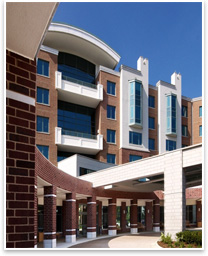
Bridgewater Place Enhances Wellness for a New Style of Senior Living by Cynthia Young
Summary: The national architecture firm, Dorsky Hodgson Parrish Yue Architects (DHPY) has recently completed construction of Bridgewater Place, a 260,000-square-foot, six-story, 170-unit continuing care retirement community (CCRC) that is repositioning for the future the existing Friendship Village of Schaumburg, Ill. What makes the development unique? A design that reflects the wants and needs of a new generation of baby-boomer seniors, blends senior living into the surrounding community, and enhances wellness by connecting residents with each other and the outdoors. When visitors drive up to the entrance of Friendship Village of Schaumburg, Ill., architecturally it seems less like a traditional retirement community and more like a hotel or resort. “It’s an important point—architecture that is engaging, uplifting, and connected with nature,” says Cornelia C. Hodgson, head of Dorsky Hodgson Parrish Yue’s Senior Living Studio. “Part of our philosophy is to design for living. The greatest compliment we can receive is when someone does not know it is a senior community; that rather it is a residential setting that is part of the overall community.” This philosophy of engagement with nature and the community has been incorporated throughout the contemporary development, which is the second phase of the repositioning of the 30-year-old, 700-unit continuing care retirement community, Friendship Village of Schaumburg. In designing the new addition, Bridgewater Place, the architecture firm sought to capture the active outlook on life and emphasis on wellness embraced by an expanding demographic of aging baby boomers.
“We are dealing with a population that is engaged in life and has a variety of opinions and desires, one of which is architectural variety,” says Hodgson of the building’s design, which is rooted in the wooded landscape, lake, and wetlands that border the complex. The architecture combines several materials, including brick, stone and stucco, to articulate the six stories and the length of the building. The new, long, serpentine structure takes its form from the shoreline of its adjacent lake. One architectural challenge was to diminish the scale of the travel distance from one end of the building to the other. The firm incorporated atriums to join sections of the structure and incorporated natural light throughout. “Several segments are connected at angles that allow natural light into the corridors,” says Hodgson. “It is enlivening and engaging. Nature is an important part of the building, incorporating natural light as a wellness design principle.” Uniting old and new
Inside, the new apartments feature larger units with bedrooms, bathrooms, balconies, upgraded kitchens, and upscale interior design. They are also designed with gerontological sensitivity and accessibility in mind, such as wider rooms, hallways, and bathrooms to accommodate walkers and wheelchairs. More to come The Friendship Village project was recently selected for publication in the AIA’s 2007 Design for Aging Review, which was announced at the October annual meeting of the American Association of Homes and Services for the Aging. According to Ziegler Capital Markets Group, Friendship Village is the 15th largest CCRC in the nation. “We strongly believe that the environment affects people’s behavior,” Hodgson concludes. “We’ve designed it in a way that says this is a place to engage in life. Senior living is very different today; it is not just a nursing home or assisted living. It is a real lifestyle choice —a place that enhances wellness for a new style of senior living.” |
||
Copyright 2007 The American Institute of Architects. All rights reserved. Home Page |
||
home
news headlines
practice
business
design
recent related
› Innovation in Design for Aging Requires Shared Vision
› Workshop: Neuroscience of Facilities for the Aging and People with Alzheimer’s
Photos © Dorsky Hodgson Parrish Yue.
To learn more about the AIA Design for Aging Knowledge Community, including available publications and events, visit their page on AIA.org.

 How do you . . .
How do you . . . 
